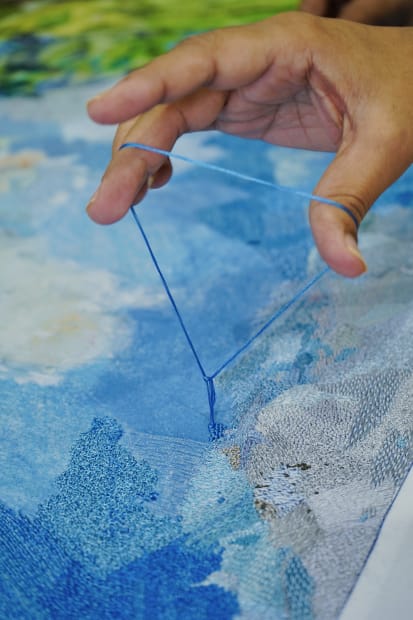
India’s rich embroidery traditions encompass a diverse range of techniques, each with its own unique artistry and cultural significance. Among these, Aari and Zardozi embroidery stand out for their intricate craftsmanship, historical roots, and timeless elegance.
Aari Embroidery
Aari embroidery is a refined hand-embroidery technique that uses a hooked needle, known as the Aari needle, to create delicate chain stitches. This method allows artisans to produce continuous, intricate patterns with precision, often incorporating silk threads, beads, and sequins.
Zardozi Embroidery
Zardozi, meaning "gold work," is a centuries-old embroidery technique that originated in Persia and flourished in India during the Mughal era. This opulent style involves hand-stitching gold and silver threads, metallic wires, beads, and precious stones onto fabrics like silk and velvet. Known for its regal and three-dimensional appearance, Zardozi continues to be a symbol of luxury and intricate craftsmanship.

Base Fabrics
Cotton Satin – Cotton satin has a smooth, even texture that provides an excellent foundation for embroidery stitches without snagging or distortion.
Types of Threads
Threads play a vital role in defining texture, color, and sheen in embroidery. We use a combination of fine threads to create various textures on motifs and bring the artwork to life. Some of the thread materials we use are highlighted below:
Silk Threads – Luxurious with a natural sheen, silk threads are perfect for fine embroidery work. Often used in couture and heirloom embroidery.
Cotton Threads – Versatile, durable, and easy to work with, cotton threads are commonly used for traditional and daily-use embroidery. They provide a matte finish.
Metallic Threads – Often used to create shimmering effects, metallic threads are commonly seen in royal or festive embroidery styles like Zardozi.
Wool Threads – Used for raised textures and bold motifs.
Bullion Thread – Made of fine coiled metal, bullion thread gives embroidery a richer appearance. It adds texture, depth, and shine, making the embroidery three-dimensional.

Artwork Selection & Study
We invite renowned contemporary artists to explore uncharted territory by creating entirely new artworks designed specifically for translation into hand embroidery. This is not merely about reinterpreting existing pieces; it’s about giving artists a platform to experiment, innovate, and push the boundaries of their creative process.
Each artist crafts works that embrace the tactile and textural possibilities of embroidery. Whether exploring mixed media, layered compositions, or intricate details, they design with the knowledge that their vision will come to life through thousands of stitches.
Once the artwork is complete, our team meticulously studies its colors, strokes, and textures, working closely with the artist to translate their brushwork into threadwork.
Every step of this process is a dialogue—an exchange between the artist and artisan—ensuring that the final embroidered piece is not merely a reproduction, but an elevated, multi-dimensional extension of the artist’s original vision.
This seamless collaboration between artist and artisan breathes new life into contemporary art, transforming paintings into masterpieces of embroidery.
This website uses cookies
This site uses cookies to help make it more useful to you. Please contact us to find out more about our Cookie Policy.